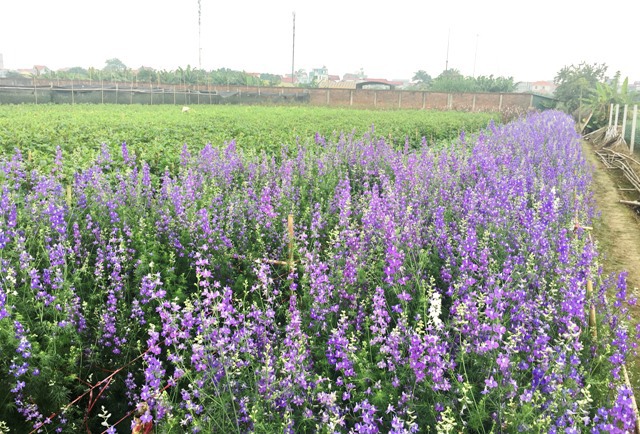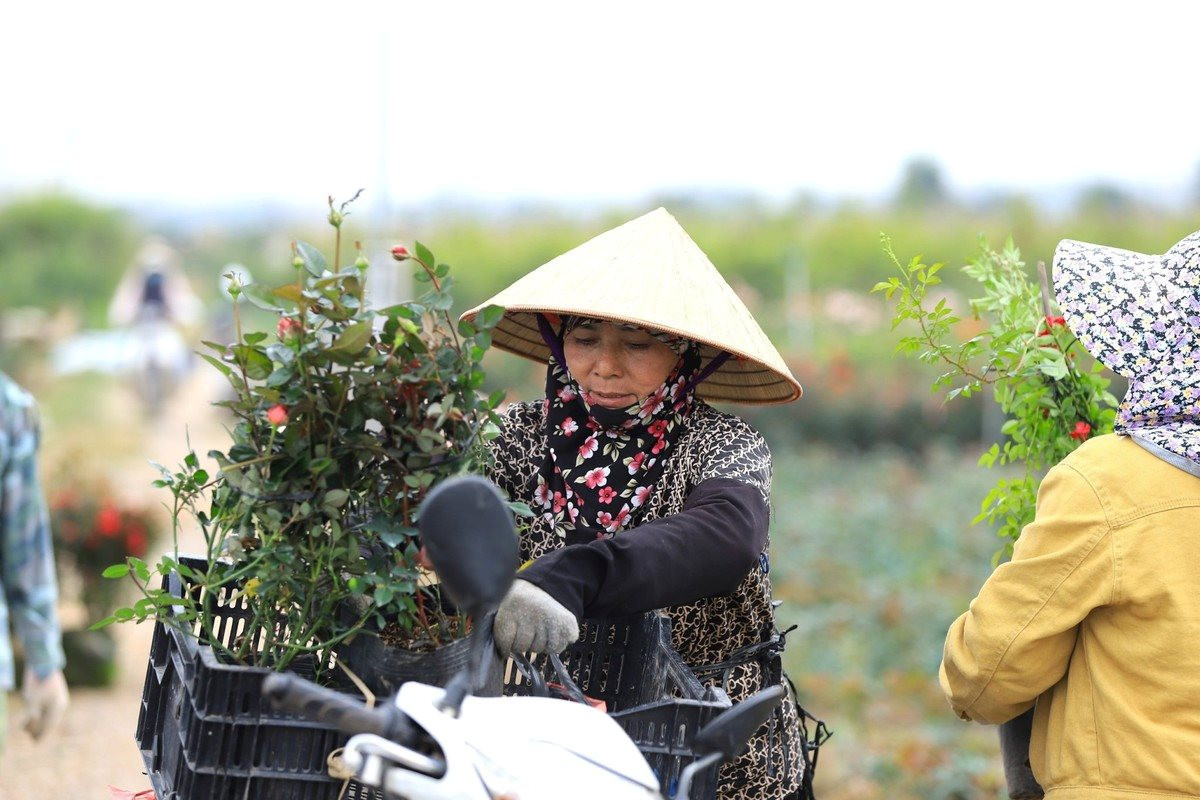
Hanoi aims to make ornamental flowers and plants its top agricultural product while transforming its agricultural landscape in a plan to get 10% in the sector's annual growth rate of 10% for 2022-2030 set by the Department of Agriculture and Rural Development.
By 2025, the value of flower and ornamental plant production is projected to soar to around VND10 trillion (US$406.6 million), with a target of VND15 to 20 trillion ($610.1-$813.5 million) by 2030. Cultivating just one hectare of these vibrant plants could yield an impressive VND700 to 750 million ($28,413-$30,443) annually.
To turn this vision into reality, the department will roll out a series of dynamic and coordinated strategies.
Creating a thriving environment for the sector
| A violet garden blooms in Tay Tuu Flower Village. Photo: Lam Nguyen/ The Hanoi Times |
According to the Municipal Department of Agriculture and Rural Development, Hanoi is committed to creating an ideal environment for businesses to flourish in the ornamental flower and plant trade. With a focus on innovation, enterprises, and cooperatives will become the driving force behind market development, forging strong links with producers to ensure seamless distribution of floral products.
The vision is to build a robust production chain with businesses at the center, working with local households through cooperatives and cooperative groups. This partnership will establish dedicated growing areas, streamline production processes, and improve product preservation and distribution.
This strategic approach aims to stimulate significant growth in the landscape sector, paving the way for holistic and sustainable development, while actively contributing to the creation of vibrant new-style rural areas and thriving urban landscapes.
"In the area of science and technology, the department will enable organizations and individuals to research and cultivate new ornamental plant varieties. These varieties will not only meet but exceed the growing demands for beauty and cultural significance in domestic and international markets," the department said.
Moreover, the city agency plans to focus on flower and ornamental varieties that meet specific criteria for trade and intellectual property protection. Research will focus on refining the entire production process - from breeding and planting to maintenance, harvesting, processing, and preservation.
In addition, sustainable farming practices are encouraged to reduce reliance on inorganic chemicals while promoting the use of organic and microbial fertilizers and pesticides.
The department is committed to preserving and enhancing the genetic diversity of ornamental plants, creating a vibrant array of products and valuable genetic resources for research and breeding.
By prioritizing the transfer and application of cutting-edge science and digital technology, the department aims to revolutionize the management, production, and consumption of these beautiful products.
It will update and refine the standards and regulations for flowers and ornamental plants to ensure that they are in line with today's requirements.
In exploring market consumption, the department will delve into the cultural significance of ornamental plants in the home, while also examining everyday domestic markets and festive occasions. This includes the growing demand for flowers and plants in workplaces, busy streets, urban spaces, residential areas, and industrial zones.
The agency emphasized that the goal is to diversify the flower and ornamental plant offering to appeal to a wide range of customers, with a strong focus on innovative packaging, eye-catching labeling and transparent product origins.
The department will organize exhibitions, competitions, and themed festivals to showcase and promote the capital's floral products. In the export arena, it will improve self-declaration procedures and ensure copyright protection for unique ornamental varieties.
To encourage investment, the Department has a diverse approach to funding the ornamental sector, emphasizing a partnership between companies and local communities.
Families will play a vital role in cultivating designated areas for flower and plant production. Cooperatives will work with households and businesses to invest in processing facilities and storage solutions, while businesses will build strong brands and establish systems to preserve and market these floral treasures.
Hanoi leads the country as a flower powerhouse
| A flower farmer in Me Linh district is harvesting. Photo: Hanoimoi Newspaper |
According to Nguyen Xuan Dai, Director of Hanoi's Department of Agriculture and Rural Development, the city is a national leader in the volume and value of ornamental plants.
By the end of 2023, Hanoi was home to over 8,100 hectares of flowers and ornamental plants, generating VND7 trillion ($284.3 million) with 70% of this area located in the districts of Bac Tu Liem, Tay Ho, Me Linh, Dan Phuong, and Thuong Tin. The local government plans to expand the area to 9,000 ha by 22025.
Innovative cultivation models take advantage of the latest advances in plant varieties and cultivation techniques, resulting in higher productivity and better quality. The average production value of flowers and ornamental plants in Hanoi ranges from VND0.5 billion to VND1.5 billion ($20,324-$60,974) per hectare per year, Dai said.
Tay Tuu Flower Village in Bac Tu Liem District is one of the largest in Hanoi with 57% of households growing flowers. The production value reaches VND820 million ($33,313) per hectare.
The city has also set up 47 special flower production zones covering 1,800 hectares, with each zone averaging 10 to 20 hectares, said Nguyen Van Chi, Deputy Head of the Hanoi Coordination Office of the New Rural Area Construction Program.
These zones are strategically located in districts such as Bac Tu Liem, Tay Ho, Me Linh, Dan Phuong, Thuong Tin, and Gia Lam. Notably, over 30% of this area is now dedicated to high-quality flower cultivation, with further expansion planned this year. A variety of stunning flowers, including chrysanthemums, lilies, and orchids, are being exported.
Hanoi is celebrating its vibrant heritage with the designation of 14 flower and ornamental plant craft villages, according to the city's Department of Agriculture and Rural Development.
From the picturesque villages of Co Giao and Xam Xuyen to the famous Noi Thon and the beloved Peach Blossom Village of Nhat Tan, these places are bursting with color and creativity. In particular, 36 exquisite floral products have achieved the coveted OCOP (One Commune, One Product) status, shining with three stars or more.
Local insiders noted that rapid urbanization in the city, coupled with a growing population and traffic, has led to challenges such as air pollution and limited green spaces. The ornamental plant industry is advocating a visionary approach to enhance public spaces with greenery and vibrant blooms, transforming urban areas into peaceful retreats.
The city envisions a vibrant future for its craft villages and rural industries, celebrating local culture through ornamental plants. This includes rethinking production and business models, strengthening trade and linking it to rural tourism, and establishing Hanoi as a true flower paradise.



